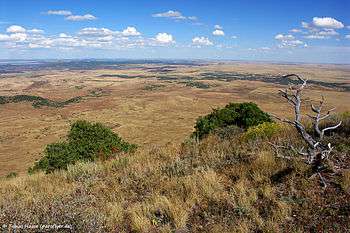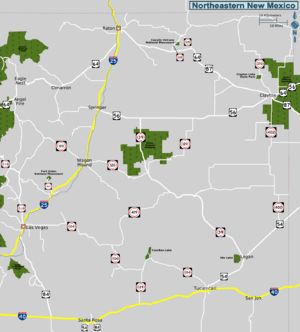Northeast New Mexico
Northeast New Mexico is a very rural region bordering the Texas Panhandle and southern Colorado. There are fewer scenic and cultural attractions here than in most other regions of the state, but the area does contain a few things to break the tedium of the drive west across the Great Plains en route to the better-known tourist areas of Santa Fe and north central New Mexico, including a pair of national monuments and some historic towns.
Cities

- 🌍 Cimarron - A historic town once located along a branch of the Santa Fe Trail, now serving as a gateway to the surrounding mountains.
- 🌍 Clayton - A town near the Texas border that's home to remnants of the historic Santa Fe Trail, a rich bed of fossil dinosaur tracks at nearby Clayton Lake State Park, and the vast landscape of the surrounding Kiowa National Grassland.
- 🌍 Las Vegas (not to be confused with the more famous city in Nevada by the same name) sits on the eastern side of the Sangre de Cristo Mountains and is an under-appreciated gem of a town, with numerous historic buildings and sites from when the city was a roaring railroad town.
- 🌍 Mora - Situated in a valley on the eastern side of the Sangre de Cristo Mountains, this is a small historic town well off the beaten path.
- 🌍 Raton - A town along I-25 near the Colorado border, home to some historic attractions and a gateway to mountain scenery nearby.
- 🌍 San Jon - A tiny village along old Route 66.
- 🌍 Santa Rosa - A town along I-40 and historic Route 66 that's home to the Blue Hole, an improbable spring/lake that's worth a look; if for some reason you're hauling scuba gear across this arid terrain, you can break it out here for an unexpectedly interesting dive.
- 🌍 Tucumcari - A small town along I-40 that's noted for its wealth of neon and historic signs associated with historic Route 66.
Other destinations
- 🌍 Capulin Volcano National Monument - A small national monument east of Raton that preserves a relatively recent volcanic field centered on the Capulin cinder cone, believed to have erupted about 6000 years ago. A visitor center is perched on the rim of the volcanic crater, with trails that reach the floor of the crater.
- 🌍 Fort Union National Monument - Situated off I-25 north of Las Vegas, this historic site preserves the ruins of an important 19th-century fort along the Santa Fe Trail.
- 🌍 Santa Fe Trail - Remains of this historic trail can be found in this region. The state of New Mexico has done a good job of erecting markers where the Trail crosses highways, with interpretive text in many locations, some of them photogenic. If you'd like a more up-close-and-personal experience with the Trail, start by visiting Fort Union National Monument.
- Several small wildlife refuges in the region provide breaks from driving, particularly during bird migration season. The largest in the area is 🌍 Las Vegas National Wildlife Refuge east of Las Vegas, while the most convenient to the cross-country traveler is a small area at Lake 🌍 Tucumcari, near the town of the same name along I-40. You'll also have chances to see wildlife as you drive here; the area east of I-25, for example, is rich in pronghorn antelope.
Understand

This region can be thought of as bounded by:
- On the north, the Colorado state line;
- On the east, the Oklahoma and Texas state lines;
- On the south, Interstate 40, following the historic route of the famous Route 66;
- On the west, the Sangre de Cristo Mountains and their foothills.
This is one of the "empty" corners of New Mexico, with low population density and comparatively few attractions. Culturally, it has many affinities to the "panhandle" regions of Oklahoma and Texas. Geographically, it forms the western edge of the Great Plains and gradually rises to meet the Sangre de Cristos, with a band of ancient (and, in a few areas, more recent) volcanoes running southwest to northeast toward the state's northeastern corner to provide a little scenic variety.
Talk
Mainly to yourself; this is a very empty region. Non-English speakers are in shorter supply than in some other areas of New Mexico, but you may have some opportunities to use Spanish, particularly in some of the small towns near the Sangre de Cristos where Spanish may even be the dominant language. Many natives from eastern New Mexico speak with a Southern accent.
Get in
The nearest major airport is in Albuquerque just beyond the southwest corner of the region. Interstate highway 40 forms the southern boundary of the region, and I-25 runs through it north to south, so highway access is generally not a problem. The primary Amtrak line across the Southwest, the Southwest Chief, follows I-25 through this region, but stations are few and far between, with just one stop in Las Vegas and another in Raton.
Get around
Drive. The high plains generally pose fewer driving difficulties than other parts of the state, but make sure to keep your car well fueled owing to the paucity of service stations except along the interstates. Blizzards occasionally roar through in the winter and can close the roads for short periods.
Stay safe
The usual comments on driving in the Great Plains apply. This is a good area in which to keep your gas tank full; towns are few and far between, and you don't want to run out of gas forty miles from nowhere. There is very little crime (after all, there's very little population) and no public health hazards of any unusual significance.
Go next
- The Sangre de Cristo Mountains, beyond the western edge of the region, are full of interesting attractions, including the classic travel destinations of Taos and Santa Fe.
- If you're following the Route 66 itinerary (which follows I-40 through the area), the section of the road east of this region is one of the most boring on the entire highway; however, there are several points of interest on the westbound side, as you head into the central region. Clines Corners is a wide spot in the road on the boundary between northeast and central that's of no great interest itself (well, a little interest for its historic role of servicing travelers on 66 -- grab a tank of gas and some munchies) but serves to alert you that more interesting terrain lies ahead.
- I-25 leaves the state north of Raton and continues over Raton Pass into Colorado. Trinidad is the first town north of the state line and has several points of interest connected with the Santa Fe Trail, as well as serving as a departure point for roads heading west into the Colorado mountains.